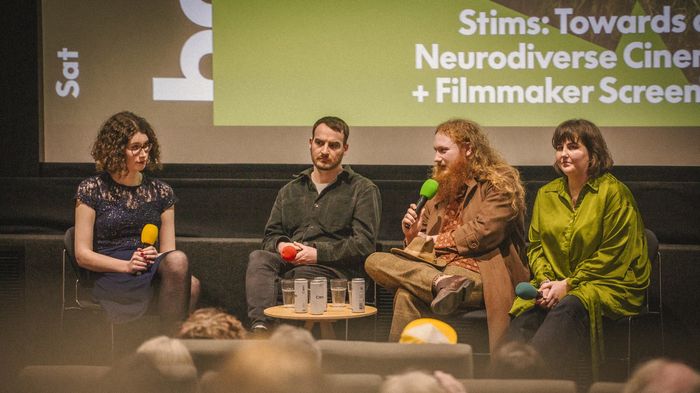Clay babies and pregnant golems
Anna Geary chats to the students behind Watersprite-nominated film Beresheith

Beresheith is a captivating and sensory short experimental film made by Nicola Medicoff, Katie Wrench and Fin Scott in their final year of studying English at Cambridge. The film consists of three distinct scenes: an artist painstakingly moulds babies out of clay and is compelled to crush one between her hands; a young woman visiting a gallery observes the statue of a pregnant golem whilst listening to an audio guide stammer disconcertingly to a stop; the golem comes to life through stop motion animation and sculpts a baby from its own clay flesh. We spoke to the makers of Beresheith, a finalist in the experimental film category at Watersprite Film Festival, about claymation, slow cinema and maternity.
How did the project come about and what inspired the concept?
Nicola: There’s a temple-like building owned by Caius college called Finella, which was the setting for the second scene in the film. The composer Robin Holloway, who was living there, told me about a past exhibition of Jacob Epstein’s sculpture of a pregnant woman and I was intrigued by the image of the artwork in that space and the early 20th-century obsession with sculptures of petrified pregnancy. I went to Katie with my ideas and we worked on the script and visual concepts over the summer of our second year. Robin also lent us a book about golems – a capitalistic folkloric figure that is a servile analogue of the human, which humans themselves can make. We were interested in these parallels and the idea that the golem’s agency is what makes it scary. Rather than depicting a violent male golem, we created a golem that could reproduce itself.
How did you find the process of creating and editing a 16-minute film?
Fin: We shot the film throughout our final year and I edited it over the summer. It was originally meant to be 5 minutes long but we needed more time to establish the intimacy between the mother and the child she is making. It was challenging to work out the pacing because each scene could have been its own 5-minute film and there isn’t really a narrative arc. I was interested in slow cinema and the delicacy of the moment: you think you can keep on cutting down a work and it will become thicker but sometimes that means you lose things. Sometimes moments need time to acquire their significance.
How did you find working with clay and incorporating stop motion animation into the film?
Katie: None of us had done any stop motion animation before. It was three hours of Fin working with the camera and 20 hours of “Oh my God!”
Nicola: It was strange making the babies out of clay because we had to support their heads so they felt tangibly like babies. This made it painful to destroy one for the first scene. It was important for the narrative that they be made out of clay because even the tender imprints of the creator are somehow forming or deforming the child.

Fin: The quality of the clay is different in each scene. In the first, the clay is softer to make the child’s expressions look rich. We used air drying clay so that, by the end, the mother looks like a rock face, having become drier, cracked and withered, as if she has aged. This effect was magnified by the film’s composer and sound designer, Ben Nicolson, who incorporated cracking sounds into the final scene to give the impression of something moving that shouldn’t be. (Katie adds that she and Nicola crunched celery in front of a microphone to create these sounds!)
Do you have a fixed idea of how the film, particularly the ending, should be interpreted?
Katie: We wanted the final scene to be ambiguous, so people would question whether it’s as real as the first two. Spectators might ask, “Is this happening in the sculptor’s imagination or is this speculative realism? Is this something that has or will happen?”. Even we don’t really know! It’s significant that the clay creature cannot create more clay; it can only use its own body. The erasure of the face acts as an emblem of that loss. The film focuses on the idea of maternal sacrifice. People often ask us if it’s about abortion because we made it after the overturning of Roe v Wade but it’s really open to interpretation.
Nicola: We didn’t have a specific thought of what it meant but wanted to create resonant images of motherhood. The bittersweet aspect of the ending is that, in creating this creature, the mother must withdraw herself. She only understands making a baby through destruction, self-sacrifice and violence. We’re going to continue making weird sensory films but maybe with a bit more narrative next time!
 News / Uni offers students £55k in payouts31 October 2025
News / Uni offers students £55k in payouts31 October 2025 News / Uni error forces deeper spending cuts31 October 2025
News / Uni error forces deeper spending cuts31 October 2025 News / College rowing captains narrowly vote to exclude trans women31 October 2025
News / College rowing captains narrowly vote to exclude trans women31 October 2025 News / Students launch women’s society excluding trans women31 October 2025
News / Students launch women’s society excluding trans women31 October 2025 News / Cambridge launches plan to bridge ‘town and gown’ divide27 October 2025
News / Cambridge launches plan to bridge ‘town and gown’ divide27 October 2025










